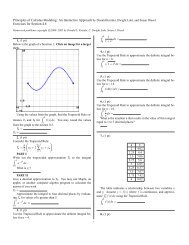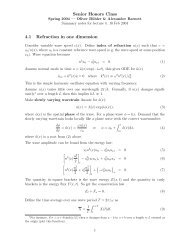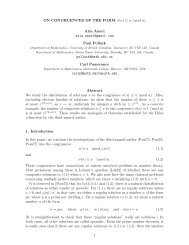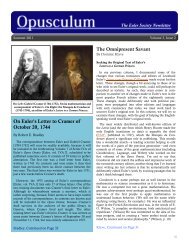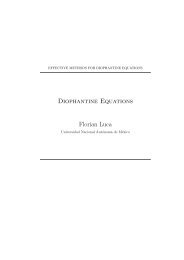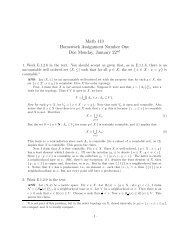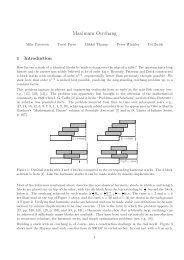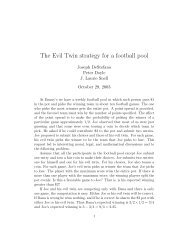Opusculum - Dartmouth College
Opusculum - Dartmouth College
Opusculum - Dartmouth College
You also want an ePaper? Increase the reach of your titles
YUMPU automatically turns print PDFs into web optimized ePapers that Google loves.
Issue Autumn #: [Date] 2011<br />
Volume Dolor 3, Sit Issue Amet 3<br />
Glaus, Continued from Page 37<br />
ing of the Pietist movement within Lutheranism to the<br />
end of the 17 th century when August Hermann Francke<br />
(1663-1727) became a professor and pastor in Glaucha<br />
near Halle in 1692. Francke is important since it is he<br />
who established the orphan asylum that is referenced in<br />
Euler’s own notes. On the whole, the Pietists were<br />
doctrinaire Lutherans preserving the content of Lutheran<br />
dogma but not the way in which it was to be delivered.<br />
The great schism that marked the Pietists was the<br />
renunciation of the Lutheran belief of justification by<br />
faith alone. The Pietists insisted on a life of ―active<br />
devotion, the doctrine of repentance, conversion and<br />
regeneration‖; these dogmatic institutions were called the<br />
Pietist conventicles and lead to regeneration through<br />
prayer, devout readings and exhortations. Even though<br />
Halle campaigned against the Pietists, and though it<br />
experienced a period of decline after the deaths of its<br />
founders Spener (1705), Francke (1727) and Joachim<br />
Justus Breithaupt (1732), the influence had already<br />
spread.<br />
King Frederick I and Frederick William I stipulated<br />
that all theologians who desired appointments in Prussia<br />
had to study at Halle for two years. However, Frederick<br />
William's successor Frederick II did not show any<br />
particular favor to them, though he did have a special<br />
affection for the Huguenot community in Prussia. In his<br />
old age he said that he was happy to have lived long<br />
enough to celebrate the Jubilee of the Revocation of the<br />
Edict of Nantes in 1785. Perhaps he wished to re-connect<br />
the religious colony with the skeptic colony, the Calvinist<br />
refugees with the philosophical redoubt, in which Pierre-<br />
Louis Moreau de Maupertuis (1698-1759), Jean Baptiste<br />
d’Argens (1701-1771), Jean le Rond d’Alembert (1717-<br />
1783), Julien Offrey de la Mettrie (1709-1751) and<br />
François Marie Arouet alias Voltaire (1694-1778) had<br />
their own brilliance. If however, Frederick II had<br />
conceived of such hope, he would have had to renounce<br />
it fairly quickly. The Protestant refugees would never<br />
have allowed themselves to be mistaken for freethinkers.<br />
So it was for the Pietists.<br />
Glaus, ____ Continued on Page 39<br />
The Euler Line<br />
The Old and the New<br />
L to R: Lutheran theologian<br />
and Pietist reformer Philipp<br />
Jakob Spener (1635-1705),<br />
Lutheran Pietist professor<br />
August Hermann Francke<br />
(1663-1727), and Frederick I of<br />
Prussia (1657-1713) [formerly<br />
Prince Frederick III]<br />
Three years ago, Suijun Jia and<br />
Ruifang Ren published a paper,<br />
"The development of Euler’s contribution<br />
to the concept of function" [in Chinese] in the<br />
Journal of Northwest University, Natural Sciences Edition 38 (3)<br />
(2008), pp. 513-516. The authors conclude that Euler’s<br />
perception of a function as an analytical expression was<br />
crucial to the transformation of the idea of function from a<br />
geometrical to an algebraic concept.<br />
A. M. Zubkov's paper, "Euler and combinatorial analysis"<br />
[in Russian] appeared two years ago in Istoriko-Matematicheskie<br />
Issledovaniya (2) 13 (48) (2009), pp. 38-48. The<br />
author surveys Euler’s work in graph theory, Latin squares<br />
and pentagonal numbers. A review by Radoslav M. Dimitric<br />
is available at Zentralblatt MATH 1202.01059.<br />
Detlef Spalt's paper, "Welche Funktionsbegriffe gab<br />
Leonhard Euler?" [in German], appears this month in<br />
Historia Mathematica 38 (2011) pp. 485-505. From the<br />
abstract: Leonhard Euler's notion of function as an<br />
"analytical expression," occasionally denoted by f (x), is well<br />
known. But it has gone unnoticed that Euler used a second<br />
well-defined notion of function for which he even coined a<br />
particular denotation: f :, used as f :x. In fact, this second<br />
notion of function is the earlier one, defined as "the ordinate<br />
which depends on the abscissa," given by the curve. Euler<br />
argues that this "geometric" notion of function is more<br />
general than the "algebraic" one. Consequently, Euler relies<br />
on this more general notion of function when he integrates<br />
functions of several variables.<br />
The Euler Archive made an appearance in the Chronicle of<br />
Higher Education, as John Bukowski's pick for the Chronicle's<br />
article on favorite online resources. Other resources<br />
that made the cut were Imaging the Iliad (an iPad app that<br />
combines text and images from the Iliad) and the Apple<br />
Examiner (a web site devoted to the tracking of ongoing<br />
upgrades and developments for Apple products).<br />
38 2






